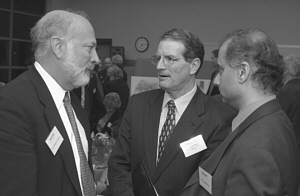|
|
Countdown to CompletionMontgomery County Campus pushes toward final phase of buildout
By Greg Rienzi |

Located in Maryland's DNA Alley, the university's 14-year-old Montgomery County Campus stands poised to make a quantum leap forward in the next five to seven years in both its size and function, as the 35-acre site in Rockville moves toward total buildout--totaling approximately 700,000 square feet of facility space.
Last week, top-level university administration held an evening reception for newly elected and current county officials to brief them about this new era of growth and development for the campus.
The event, held inside the two-year-old Academic and Research Building, introduced the local legislators to both the recently completed campus master plan and the university's strong desire to further partner in Montgomery County with private industry, government and research institutions.

|
| President William R. Brody, center, speaks with Del. Michael Gordon and Del. Kumar Barve at a reception to inform county officials about plans for the Montgomery County Campus. |
Currently, designs are being finalized for a new facility that may be as large as 130,000 square feet. The building will be the third on the campus. To be completed by the summer of 2004, it will add about 50,000 square feet of classrooms, computer labs and related academic and research space to the 98,000 square feet used by the university's schools in the first two buildings; it also will include space to be leased to other tenants--primarily science- and technology-related companies, agencies or organizations--with whom Johns Hopkins will establish academic, research or other collaborations. Construction is planned to begin in spring 2003. Four more buildings will follow soon after.
In welcoming the audience to the Dec. 10 event, Elaine Amir, director of the Montgomery County Campus, said the theme for the evening was "cooperation across boundaries and across disciplines to facilitate a meeting of the minds for the benefit of the community."
In attendance were President William R. Brody; Steven Knapp, provost and senior vice president for academic affairs; James T. McGill, senior vice president for finance and administration; Linda Robertson, vice president for government, community and public affairs; Daniel Weiss, dean of the Krieger School of Arts and Sciences; Gary Ostrander, associate provost for research and associate dean of the School of Arts and Sciences; and Ralph Fessler, dean of the School of Professional Studies in Business and Education. The invited guests of honor were Montgomery County state senators, delegates, County Council members and a representative of County Executive Doug Duncan's office. Also on hand were a number of people involved in the development of the real estate.

|
| Designed by Hellmuth, Obata + Kassabaum of Washington, the Montgomery County Campus's next building, seen here in an architectural rendering, is slated for completion in summer 2004. |
"We are reaching out to [the legislators] so that they will be aware of potential partners and financial resources for us, [including] organizations and corporations that are looking to do business in Montgomery County," Amir said. "Basically, we are asking them for their knowledge and connections to make people aware of what we are trying to do here."
President Brody told the more than 60 gathered that he envisions the campus becoming a "powerful economic development engine" for both the county and the state.
Montgomery County currently has the nation's third-highest concentration of biotechnology firms and is the largest center for gene research in the world. Many of the courses offered at the Johns Hopkins campus have been developed in academic disciplines that are of particular interest to the growing biotechnology and information technology industries emerging in the Baltimore-Washington corridor.
"In the years ahead we plan to do more research on this site and work closely with the local research community to provide the skills and facilities development to spur further growth," Brody said. "The future is here. The time is right for us to undertake a major expansion of the campus. This is not only the center of our involvement in Montgomery County, but I think it is becoming the center of expansion for our activities."
Opened in 1988, the Montgomery County Campus--located in the Shady Grove Life Sciences Center along the Interstate 270 corridor--hosts more than 40 part-time graduate and undergraduate degree and certificate programs that annually attract more than 8,300 course enrollments. Classes are offered by the Krieger School of Arts and Sciences, the Whiting School of Engineering, the School of Professional Studies in Business and Education and the Johns Hopkins Bloomberg School of Public Health.
Gary Ostrander said the university is currently engaged in talks with various small to midsized biotechnology, information technology, computer security and engineering companies with which it hopes to partner.
"Our activity here is clearly accelerating," said Ostrander, who opened his presentation with a splashy two-minute "video brochure" highlighting Hopkins' presence in Montgomery County. "We are interested in talking to any entity that is interested in partnering with Hopkins in a meaningful way as we move forward and develop new programs here."
| GO TO DECEMBER 16, 2002 TABLE OF CONTENTS. |
| GO TO THE GAZETTE HOME PAGE. |